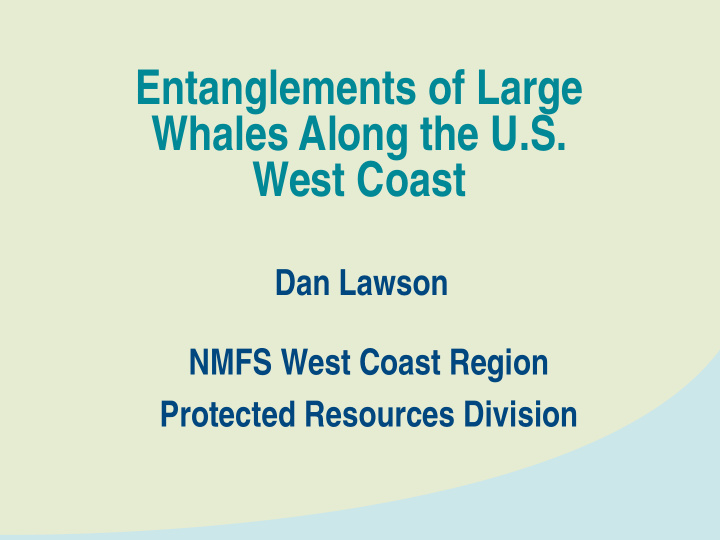



Entanglements of Large Whales Along the U.S. West Coast Dan Lawson NMFS West Coast Region Protected Resources Division
WCR Whale Entanglements • Dramatic increase in reports since 2014 • Driven by humpback whales, but now including blue whales • High demand for updates and evaluation of incoming data • Quality of reporting improving U.S. Department of Commerce | National Oceanic and Atmospheric Administration | NOAA Fisheries | Page 2
3
Sources of Confirmed Whale Entanglements 2015-2017 Humpback whales All whales Blue whales Gray whales
2018 summary thus far **considered preliminary, data through 5/29/2018** 16 confirmed entangled whales, 20 total reports • • Gray whales: 10 confirmed, 12 total • Humpback whales: 5 confirmed, 6 total • Fin whales: 1 confirmed, 1 total • Unidentified: 0 confirmed, 1 total Confirmed fisheries associated with entanglements: 9 reports • • Commercial Dungeness crab: 6 total • 3 WA (2 gray whales, 1 humpback whale) • 1 OR (1 gray whale) • 1 OR and CA (1 humpback) • 1 WA tribal (humpback whale) • Gillnet: 3 (gray whales) Reporting location • • California: 10 confirmed reports, 14 unconfirmed • Washington: 6 confirmed reports U.S. Department of Commerce | National Oceanic and Atmospheric Administration | NOAA Fisheries | Page 5
What we think is going on • Complex relationship between whale distribution/abundance/behavior, environmental variability/prey distribution, fishing effort distribution, public awareness • Better documentation and increasing response has increased ability to identify gear (along with trap tags) , but still limited NOAA MMHSRP 18786 • Trap/pot fisheries identified as the majority entangling gear (when known); Dungeness crab fishery = large co-occurrence • Whales are getting entangled every way possible, in all types/colors/arrangements of NOAA MMHSRP 18786 gear – not likely to be easy fix U.S. Department of Commerce | National Oceanic and Atmospheric Administration | NOAA Fisheries | Page 6
What we don’t know (data gaps) Entanglement Data NOAA MMHSRP 18786 • Identifying entanglement origins (when/where to focus research/management) • Knowing the total # of entanglements that actually occur • Understanding how whale behavior and gear configuration could make an interaction become an entanglement • Understanding outcomes of entanglements (long term survival, serious injuries, impacts of reproduction) U.S. Department of Commerce | National Oceanic and Atmospheric Administration | NOAA Fisheries | Page 7
Entanglement Mortality and Serious Injury – PRELIMINARY* • 136 humpback whale entanglement records evaluated 2007-2016 (draft); ~94 M/SI = 69% M/SI rate 2017 draft SARs: average Average M/SI 2012-2016 2016 entanglement M/SI M/SI for 2011 - 2015 entanglements (prelim.) (Carretta et al. 2018 draft) DGN 0.02 CA spot prawn 0.5* CA spot prawn 1.75 CA spot prawn 0.15 CA Dungeness 3.15* CA Dungeness 12.5 CA Dungeness 0.65 Sablefish 0.5* Sablefish 1.5 Sablefish 0.2 Unk/unidentified 6.6 Unk/unidentified 19.75 Unk/unidentified 9.75* total 7.62 total 35.5* total 13.9* • Disentanglement “saved” ~13 humpbacks 2012-2016 • Blue whales: 1 M/SI in 2015; 3.5 in 2016 (draft) 8
What Other Issues Are Entanglements Creating? • Management under MMPA – Potential Biological Removal for CA/OR/WA humpback whales is 11 seriously injured or killed per year; CA/OR/WA blue whales 2.3 seriously injured or killed per year • Humpback and blue whales are protected by the ESA • Public perception of entanglements and associated fisheries is unpopular – market concerns • Increased pressure on disentanglement response – inherently dangerous and not a solution U.S. Department of Commerce | National Oceanic and Atmospheric Administration | NOAA Fisheries | Page 9
What Can We Do To Reduce Entanglements? • Reduce the co-occurrence of whales and fishing gear (and debris) • Improve the gear to make it less likely to entangle whales (and other things) • Improve the gear to make entanglements less severe and/or more likely whales can escape from gear • Deterrence and Avoidance • Get smarter – fill in knowledge gaps (e.g., gear marking)
Ecosystem Approach? 11
Recommend
More recommend